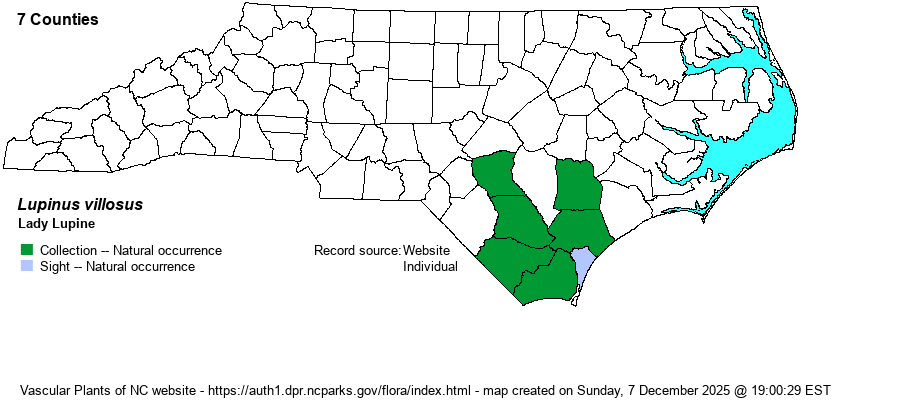| Author | Willdenow | |
| Distribution | Limited only to the southeastern corner of the state, north to Duplin and Cumberland counties. However, it is probably extirpated from one or two of these counties, including Duplin.
This is a Southeastern species limited to the Coastal Plain, north to southeastern NC, south to central FL, and west to eastern LA. | |
| Abundance | Strongly declining over the past several decades. Limited to just 5-10 sites now, and many of these are in very poor condition. Very rare to rare, with most current sites in western Pender County and in a powerline clearing in Cumberland County. This was a Significantly Rare species, but in May 2021 it has been rightly elevated to State Endangered species status. | |
| Habitat | This species is limited to sandy places, historically mostly in drier Longleaf Pine (Pinus palustris) sandhill habitats, but now found mostly on sandy roadbanks, powerline clearings, and other sandy openings. |
| Phenology | Blooms from April to May, and fruits from June to August. | |
| Identification | The leaves of this species look very similar to those of the much more numerous L. diffusus, which can occur over the same area. Each is somewhat "stemless", with a good number of leaves growing at ground level and mainly ascending; these are elliptical in shape, about 4 inches long, and about 1.5 inches wide. They are very villous, even more hairy than the leaves of the other species. Also, the flower stalks are very shaggy-villous, and they reach about 10-12 inches tall, but instead of light blue flowers the flowers of L. villosus are flesh-pink, with a dark purple center on the standard, giving the flower a most striking and unusual color combination. The flowers, each about 1/2-inch across, make the inflorescence about 1-2 inches broad and at least 6 inches tall. One can argue that this is among the most beautiful of the Coastal Plain wildflowers, enhanced by its rarity. It is likely that a few populations still remain to be discovered in NC, but sadly many locations have been lost to development, pine plantations, fire suppression, and other factors. | |
| Taxonomic Comments | None
| |
| Other Common Name(s) | Pink Sandhill Lupine, Hairy Lupine | |
| State Rank | S1 | |
| Global Rank | G4 | |
| State Status | E | |
| US Status | | |
| USACE-agcp | | |
| USACE-emp | | |

